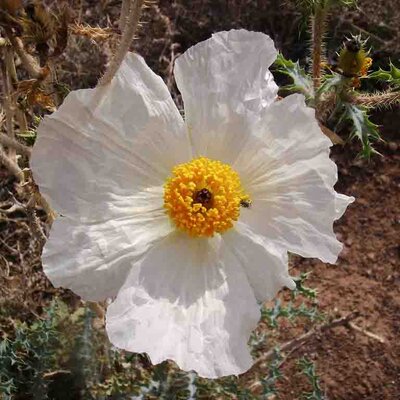
Argemone pleiacantha
This medicinal species has white flowers 16 cm in diameter, blue-green foliage and seed capsules almost 4 cm long. The whole plant is covered with prickles, hence its botanical name "plei/acantha" - meaning "many thorns" in Greek.
in bucket
For spring sowing, place seeds in a damp substrate in the refrigerator for 60 days to lift dormancy. Monitor regularly and sow in pots if germination begins, taking care not to cover the seeds too much. For autumn sowing, sow lightly in trays. Cover lightly with fine soil and leave outdoors throughout the winter.
Argemone pleiacantha is native to the southwestern USA and Mexico and needs lots of heat!
February, March, April, May
June, July, August, September, October
in the ground
sunny
low
sandy, gravel
drained, sec, reheated
Argemone pleiacantha
mid-season
50 seeds
White
From 60 to 120 cm
16 cm
The seeds are edible, but have a narcotic and sedative effect. Pulverized in water, they are laxative. The Shoshoni people used them to treat boils and skin lesions. The Paiute people used seed oil to treat burns. The Comanche people used it for ophthalmic problems. The name of the species in Greek, "argemos", means "white spot in the eyes" and evokes its use to eliminate cataracts. The juice of the plant is used to treat warts, skin lesions and, very diluted, to cure cataracts. A decoction of the plant is used to treat burns. An infusion of its leaves relieves kidney disease. According to laboratory studies, this species has anti-malarial, anti-microbial, anti-carcinogenic, sedative and anti-inflammatory properties. It is also a homeopathic remedy. Its anti-carcinogenic properties have been validated against cancers of the lungs, colon, blood, etc. In terms of alkaloids, this species is characterized above all by the preponderant presence of berberine and, to a lesser extent, laudanausine, and by the absence of argemonine. Pigeons of the Zenaida macroura species feed on its seeds.






